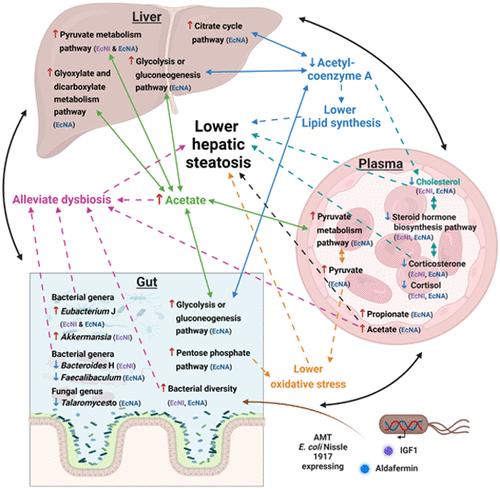在小鼠模型中,先进的微生物组疗法通过恢复肠道微生物群平衡和肠-肝轴加速MASLD的恢复
IF 6.2
1区 农林科学
Q1 AGRICULTURE, MULTIDISCIPLINARY
引用次数: 0
摘要
肠道菌群失调和内分泌失调是代谢功能障碍相关脂肪变性肝病(MASLD)发展的关键因素。本研究评估了先进的微生物组治疗是否可以在MASLD恢复期间恢复肠道微生物平衡和肠-肝轴平衡。采用高脂高糖饮食诱导小鼠MASLD,然后转移到标准饮食,干预组接受表达IGF1 (EcNI)或alafermin (EcNA)的工程大肠杆菌Nissle 1917,对照组接受大肠杆菌Nissle 1917载体(EcN)或无微生物干预(CTRL)。与对照组相比,EcNI和EcNA通过降低肝脏脂肪、血浆胆固醇和体重,同时增加细菌多样性、血浆醋酸盐和丙酸盐,以及调节特定的微生物群,改善了MASLD的恢复,潜在地缓解了生态失调。此外,EcNI和EcNA下调了类固醇激素生物合成途径乙酰辅酶a, EcNA上调了与氧化应激减少有关的戊糖磷酸途径和丙酮酸。这些结果表明EcNI和EcNA是潜在的治疗MASLD的新方法。本文章由计算机程序翻译,如有差异,请以英文原文为准。

Advanced Microbiome Therapeutics Accelerate MASLD Recovery by Restoring Intestinal Microbiota Equilibrium and the Gut-Liver Axis in a Mouse Model
Gut microbiota dysbiosis and endocrine dysregulation are key players in metabolic dysfunction-associated steatotic liver disease (MASLD) development. This study evaluated whether advanced microbiome therapeutics can restore intestinal microbial equilibrium and gut-liver axis balance during MASLD recovery. MASLD was induced in mice using a high-fat, high-sugar diet, and then shifted to a standard diet, where intervention groups received engineered Escherichia coli Nissle 1917 expressing IGF1 (EcNI) or aldafermin (EcNA), and control groups received E. coli Nissle 1917 vehicle (EcN) or no microbial intervention (CTRL). EcNI and EcNA improved MASLD recovery compared to controls by lowering hepatic fat, plasma cholesterol, and body weight, while increasing bacterial diversity, plasma acetate, and propionate, and modulating particular microbial groups, potentially alleviating dysbiosis. Additionally, EcNI and EcNA downregulated acetyl-CoA, the steroid hormone biosynthesis pathway, and EcNA upregulated the pentose phosphate pathway and pyruvate, which are related to oxidative stress reduction. These results suggest that EcNI and EcNA are potential novel treatments for MASLD.
求助全文
通过发布文献求助,成功后即可免费获取论文全文。
去求助
来源期刊
CiteScore
9.90
自引率
8.20%
发文量
1375
审稿时长
2.3 months
期刊介绍:
The Journal of Agricultural and Food Chemistry publishes high-quality, cutting edge original research representing complete studies and research advances dealing with the chemistry and biochemistry of agriculture and food. The Journal also encourages papers with chemistry and/or biochemistry as a major component combined with biological/sensory/nutritional/toxicological evaluation related to agriculture and/or food.

 求助内容:
求助内容: 应助结果提醒方式:
应助结果提醒方式:


